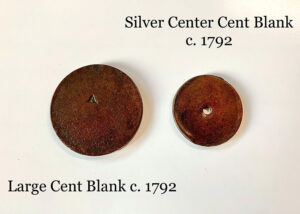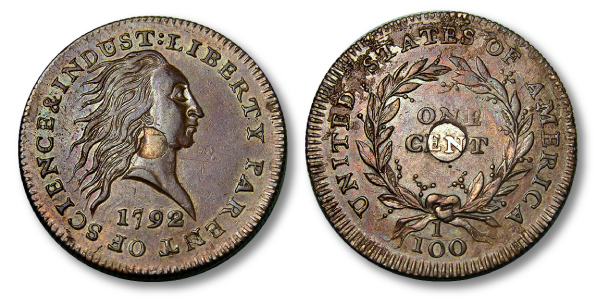By Tim Grant and Stephanie Meredith
March 1, 2023

The year 1792 was one of experimentation for the U.S. Mint. The Coinage Act of 1792 established a national mint and the monetary system of the United States, including all denominations of coins and their compositions. But before the first coins were struck for circulation, the new Mint needed to practice and experiment. Throughout 1792, the Mint produced pattern coins of some of the smallest denominations in high demand for circulation. One of these pattern coins was the silver center cent, which was an effort to reduce the amount of copper in the one-cent coin.
The Coinage Act set the composition of the cent to 264 grains of copper, the amount of copper needed to be worth one cent. That brought the coin’s diameter to 28mm, larger than today’s 24mm quarter. It would be an extremely large coin with minimal value and impractical for daily use. Moreover, the Mint had trouble buying copper for its new coinage. Copper was not only scarce, it was expensive.
In light of these circumstances, Secretary of State Thomas Jefferson and the Mint decided to make a pattern cent, different from what Congress had authorized. Chief Coiner Henry Voigt reduced the size of the cent to 21mm – the size of today’s nickel – and placed a hole in the center of the copper. A silver plug filled the hole. Thus, the silver center coin contained one-quarter cent worth of copper and three-quarter cent worth of silver – equaling one cent. The Mint created another pattern cent using an alloy of copper and silver in the same proportions. The designs of these pattern cents had a bust of Liberty with flowing hair on the obverse and a wreath tied with a ribbon on the reverse.
Jefferson and the Mint sent samples of the silver center cents to Congress to review. They also sent examples of the alloy pattern cent and the large cent authorized by Congress for comparison. After debate, however, Secretary of the Treasury Alexander Hamilton did not approve the proposed smaller cent. Production of the bi-metallic silver center cent would have been too complicated. Instead, Congress passed the Act of January 14, 1793. This legislation reduced the composition of the cent to 208 grains of copper.
The Mint is known to have produced only a handful of these remarkable silver center blanks and coins. Two silver center blanks are currently on display at the Philadelphia Mint, originating from Frank Stewart’s excavations of the original Mint building.
After the second Philadelphia Mint was built in 1833, the first building was sold and later became several shops, selling wallpaper, wagon covers, cigars and umbrellas. In 1907, Philadelphia businessman Frank Stewart bought the building. Stewart was also an amateur historian and had an admiration of the Mint’s humble beginnings. His excavations at the first Mint property turned up many early Mint artifacts including coin webbing, half cents, large cents, and many blanks. Stewart’s most notable find was two silver center cent blanks discovered in the Mint’s rafters.
The Stewart collection was later donated to the National Park Service. In 1969, NPS loaned many of these historically significant pieces to the Mint upon the opening of the current Philadelphia Mint building – including the two famous silver center cent blanks. While never circulated, these silver center pattern cents and blanks were undoubtedly the first pieces cut and struck at the new Mint building. Certainly, they were once held and studied by Mint Director David Rittenhouse, Secretary of State Thomas Jefferson, Secretary of the Treasury Alexander Hamilton, and President George Washington.
View these beautiful pieces of Mint history on a public tour of the Philadelphia Mint.

See more Inside the Mint articles.


